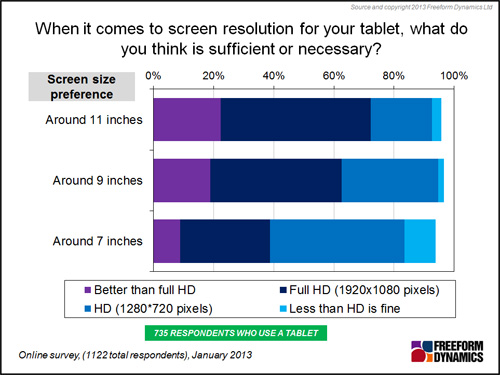By Team Freeform
The tablet and smartphone market has certainly moved on from the situation of just a few years ago. Rounded rectangles, black borders and 3.5” screens for phones and 9” screens for tablets have mushroomed into a choice of shapes, colours, sizes and textures.
Back in January we ran a survey to find out what respondents think about smartphones and tablets, and the results are now in. One of the things we were particularly interested in given the diverse range of device sizes now on the market was your take on what size you like your device to be. In particular, we wanted to see whether bigger does equal better, or if there is an ideal size beyond which things level off or get too big.
What emerged was a quite distinct set of preferences for smartphones compared with tablets. In the smartphone camp, the screen size sweet spot is in the range from 3.5” up to around 4.5” with a preference towards the larger screen size. This is the size range that can typically be held and used with one hand. Above this size, the phone requires two hands to work it effectively and is hard to fit into pockets, requiring a bag of some sort to slot it into.

When it comes to tablets though, it is a different situation. Here we can see that the minimum size is felt to be 7”, as tablets of 5” were preferred by less than 1% of respondents. Coupled with the low preference for 5” smartphones, it would appear that this screen size for smart devices is in a ‘no-man’s land’, and destined to remain niche for the time being.
The larger screen sizes of 7”, 9” and 11” are all popular, and this increases as the screen size gets bigger. Tablets are typically designed for two-handed use, and few people expect them to fit easily in a pocket. Instead, they are thin and light and intended to be carried around in a bag in the manner of things like A4 or A5 paper notebooks.
The indications though are that the sweet spot will tail off at around 11” or so, as very few respondents indicated that they would like something bigger at this point. Of course, there are not many products in the market to cater for this at the moment, so this may change in the future.
Aside from screen size, one of the other trends in screens has been to move beyond the highly pixelated screens of the earlier smartphones and tablets. The iPhone 3G had a display of 320 * 480, and the iPhone 4G quadrupled this to 640 * 960. This was revolutionary at the time but now seems commonplace with a number of phones such as the Samsung Galaxy SIII or Nokia Lumia 920 capable of displaying content at 720p HD or even 1020p full HD. So is this just a gimmick, or is this really in demand?
Looking first at smartphones, at the smaller screen size of around 3.5”, HD is already in demand as just under half of respondents thought that it was necessary and this proportion increases as the screen size gets bigger. In the most popular screen size of around 4.5” epitomised by the Galaxy SIII or Lumia 920, HD or better screens are seen as necessary by over three quarters of respondents.

When it comes to tablets, HD is all the rage – very few of you are prepared to accept less than 720p HD – even with 7” tablets this is the preferred resolution choice as a minimum. This demand doesn’t stop at 1080p HD though. In the 9” and 11” screen size preference groups, there is a trend towards an even better than HD quality screen, with around a fifth of respondents saying that this is their requirement.

While HD media is certainly helping drive this shift to higher density screens, the preference that many have for doing email or web browsing on their devices is also helping to create demand for a crisper, clearer display. So when it comes to screen size, bigger is not always better with respect to smartphones, but it generally is when it comes to tablets.
N.B. This survey was carried out on The Register IT information and news site, so is a self-selecting sample and may not be representative of the general population.
CLICK HERE TO VIEW ORIGINAL PUBLISHED ON

Through our research and insights, we help bridge the gap between technology buyers and sellers.





Have You Read This?
From Barcode Scanning to Smart Data Capture
Beyond the Barcode: Smart Data Capture
The Evolving Role of Converged Infrastructure in Modern IT
Evaluating the Potential of Hyper-Converged Storage
Kubernetes as an enterprise multi-cloud enabler
A CX perspective on the Contact Centre
Automation of SAP Master Data Management
Tackling the software skills crunch